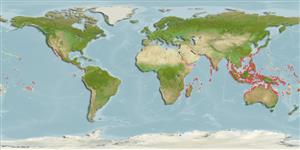Common names from other countries
>
Syngnathiformes (Pipefishes and seahorses) >
Syngnathidae (Pipefishes and seahorses) > Syngnathinae
Etymology: Syngnathoides: Greek, syn, symphysis = grown together + Greek, gnathos = jaw (Ref. 45335).
More on author: Bloch.
Environment: milieu / climate zone / depth range / distribution range
Ecología
marino asociado a arrecife; no migratorio; rango de profundidad 0 - 10 m (Ref. 90102). Tropical; 32°N - 32°S
Indo-Pacific: Red Sea and Knysna, South Africa (Ref. 4281) to Samoa, north to southern Japan, south to New South Wales.
Length at first maturity / Tamaño / Peso / Age
Maturity: Lm ?, range 19 - ? cm
Max length : 29.0 cm TL macho / no sexado; (Ref. 4281)
Espinas dorsales (total): 0; Radios blandos dorsales (total): 38-48; Espinas anales 0; Radios blandos anales: 4. Variable green to brown or grey, depending on habitat (Ref. 48635).
Occur in protected coastal shallows over or among algae, seagrasses (Ref. 41878), or floating weeds (Ref. 1602). Juveniles occasionally found near the surface (Ref. 4281). Ovoviviparous (Ref. 205). The males carry the eggs in a brood pouch which is found under the tail (Ref. 205). Used in Chinese medicine to extract Hailong, one of the important drugs (Ref. 12206). Has been reared in captivity (Ref. 35416).
Male carries the eggs in a brood pouch (Ref. 205).
Myers, R.F., 1991. Micronesian reef fishes. Second Ed. Coral Graphics, Barrigada, Guam. 298 p. (Ref. 1602)
IUCN Red List Status (Ref. 130435)
CITES (Ref. 128078)
Not Evaluated
Threat to humans
Harmless
Human uses
Acuario: Acuarios públicos
Más información
ReferenciasAcuiculturaPerfil de acuiculturaRazasGenéticaElectrophoresesheritabilidadEnfermedadesProcesamientoMass conversion
Herramientas
Special reports
Download XML
Fuentes de Internet
Estimates based on models
Preferred temperature (Ref.
115969): 24.9 - 29.3, mean 28.4 (based on 3423 cells).
Phylogenetic diversity index (Ref.
82804): PD
50 = 1.0000 [Uniqueness, from 0.5 = low to 2.0 = high].
Bayesian length-weight: a=0.00037 (0.00016 - 0.00085), b=3.18 (2.99 - 3.37), in cm Total Length, based on LWR estimates for this (Sub)family-body shape (Ref.
93245).
Nivel trófico (Ref.
69278): 3.6 ±0.6 se; based on diet studies.
Resiliencia (Ref.
120179): Medio, población duplicada en un tiempo mínimo de 1.4-4.4 años (Assuming annual Fec<1000).
Fishing Vulnerability (Ref.
59153): Low vulnerability (16 of 100).
